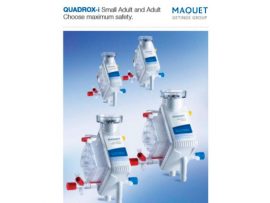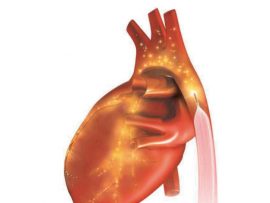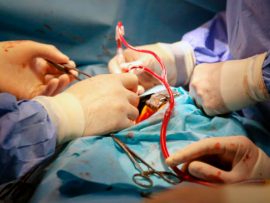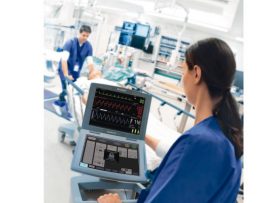Neonates and children place the highest demands on oxygenators: A low priming volume is extremely important in order to maintain the lowest possible level of hemodilution. [pdf-embedder url="https://perfusfind.com/wp-content/uploads/2021/01/QUADROX-i-neonatal-pediatric.pdf" title="QUADROX-i..
Lee masThe QUADROX-i family is growing: With QUADROX-i, Maquet offers a complete oxygenator family for each patient size, beginning with the QUADROX-i Neonatal and Pediatric up to the QUADROX-i Small Adult..
Lee masLa terapia con catéteres BIA basada en el uso de balones de mayor volumen como Sensation Plus® o Mega® es una opción eficaz como primera línea de soporte circulatorio mecánico..
Lee masCardiosave es un dispositivo de vanguardia que proporciona una terapia de contrapulsación intraaórtica fiable y absolutamente probada. Getinge diseñó Cardiosave para aportar mayor flexibilidad de uso tanto en configuración hospitalaria..
Lee masAbstract Background Bleeding as a complication is associated with poorer results in cardiac surgery. There is increasing evidence that the use of blood products is an independent factor of increased..
Lee masAbstract Although advances in knowledge and technology have improved outcomes in surgical cardiac patients over the last decade, complications following cardiac operations still remain to be potentially fatal. Gastrointestinal complications,..
Lee masIncreased Cerebral Mitochondrial Dysfunction and Reactive Oxygen Species with Cardiopulmonary Bypass
Abstract Objectives Neurodevelopmental injury after cardiac surgery using cardiopulmonary bypass (CPB) for congenital heart defects is common, but the mechanism behind this injury is unclear. This study examines the impact..
Lee masAbstract Background We designed a prospective randomized clinical study to compare unilateral and bilateral antegrade cerebral perfusion (ACP) under moderate hypethermia in open distal aortic hemiarch replacement in ascending aortic..
Lee masAbstract Introduction Anemia and blood transfusion are risk factors for morbidity/mortality in patients undergoing cardiac surgery with cardiopulmonary bypass (CPB). The objective of this study is to analyze the association..
Lee masAbstract The new coronavirus infection, which was first seen in China in late December, 2019 and eventually became a worldwide pandemic, poses a serious threat to public health. After a..
Lee masAbstract Background Recent military and civilian experience suggests that fresh whole blood may be the preferred for treatment of hemorrhagic shock, but its use is limited by its 21-day shelf life. The red..
Lee masAbstract Background Bloodstream infection (BSI) is an important complication of extracorporeal membranous oxygenation (ECMO) and a major cause of mortality. This study evaluated the epidemiological and clinical characteristics of BSI..
Lee masAbstract Objective Preoperative anemia management reduces red blood cell (RBC) transfusion and adverse outcomes, but how best to optimize the patient’s hemoglobin (Hgb) before cardiac surgery remains unclear. The authors..
Lee masIntroduction Lactic acidosis after cardiac surgery with cardiopulmonary bypass is common and associated with an increase in postoperative morbidity and mortality. A number of potential causes for an elevated lactate..
Lee masCardiosave es un dispositivo de vanguardia que proporciona una terapia de contrapulsación intraaórtica fiable y absolutamente probada. Getinge diseñó Cardiosave para aportar mayor flexibilidad de uso tanto en configuración hospitalaria..
Lee masBackground There is a lack of consensus on how to manage anticoagulation during veno-venous extracorporeal membrane oxygenation, including antithrombin monitoring and supplementation. The authors’ aim was to determine current practice..
Lee masThe use of veno-arterial extracorporeal membrane oxygenation (VA-ECMO) as a salvage therapy in cardiogenic shock is becoming of current practice. While VA-ECMO is potentially a life-saving technique, results are sometimes mitigated, emphasising the need for selecting..
Lee masVenoarterial extracorporeal membrane oxygenation has emerged as a viable treatment for patients in cardiogenic shock with biventricular failure and pulmonary dysfunction. Advances in pump and oxygenator technology, cannulation strategies, patient selection and management, and durable mechanical circulatory support have..
Lee masAbstract Extracorporeal membrane oxygenation (ECMO) refers to specific mechanical devices used to temporarily support the failing heart and/or lung. Technological advances as well as growing collective knowledge and experience have..
Lee masBackground Venoarterial extracorporeal membrane oxygenation (V-A ECMO) improves perfusion and oxygenation in patients with cardiogenic shock. However, it can also result in supranormal oxygen exposure. Recent evidence suggests hyperoxia may..
Lee masBackground Post-cardiotomy cardiogenic shock (PCCS) has an incidence of 2–6 % after routine adult cardiac surgery. 0.5–1.5 % are refractory to inotropic and intra-aortic balloon pump (IABP) support. Advanced mechanical circulatory support..
Lee masBackground Postcardiotomy cardiogenic shock (PCCS) refractory to inotropic support and intra-aortic balloon pump (IABP) occurs rarely but is almost universally fatal without mechanical circulatory support. In this systematic review and..
Lee masBackground The efficacy of extracorporeal membrane oxygenation (ECMO) in bridging children with unrepaired heart defects to a definitive or palliative surgical procedure has been rarely reported. The goal of this..
Lee masBACKGROUND: No consensus exists on the optimal settings of mechanical ventilation during veno-venous extracorporeal membrane oxygenation (ECMO). Our aim was to describe how mechanical ventilation and related interventions are managed..
Lee masSevere cases of coronavirus disease 2019 (COVID-19) cannot be adequately managed with mechanical ventilation alone. The role and outcome of extracorporeal membrane oxygenation (ECMO) in the management of COVID-19 is..
Lee masThe use of extracorporeal membrane oxygenation has had a positive impact on the outcomes after lung transplantation. Extracorporeal membrane oxygenation has a role in all phases of lung transplantation—preoperative, intraoperative,..
Lee masAcute Respiratory Distress Syndrome (ARDS) is one of the most demanding conditions in an Intensive Care Unit (ICU). Management of analgesia and sedation in ARDS is particularly challenging. An expert..
Lee masVenovenous extracorporeal membrane oxygenation (vv-ECMO) has been classically employed as a rescue therapy for patients with respiratory failure not treatable with conventional mechanical ventilation alone. In recent years, however, the..
Lee masPurpose Extracorporeal membrane oxygenation (ECMO) is a rescue therapy for patients with acute respiratory distress syndrome (ARDS). The aim of this study was to evaluate associations between ventilatory settings during..
Lee masAbstract Rationale: Current practices regarding mechanical ventilation in patients treated with extracorporeal membrane oxygenation (ECMO) for acute respiratory distress syndrome are unknown. Objectives: To report current practices regarding mechanical ventilation in patients..
Lee mas
















